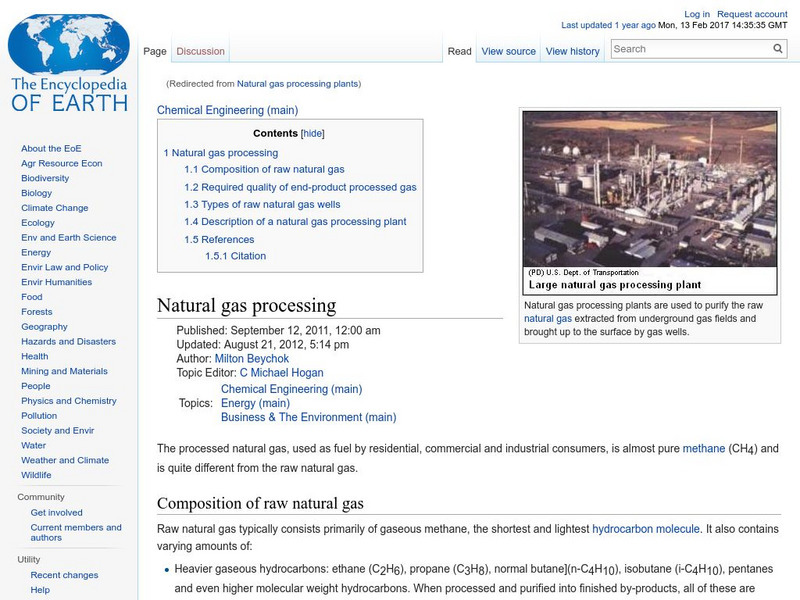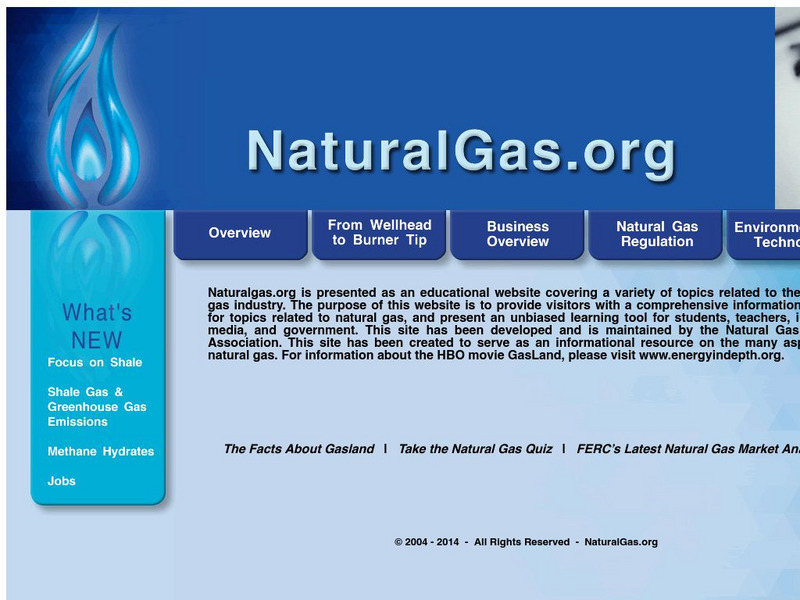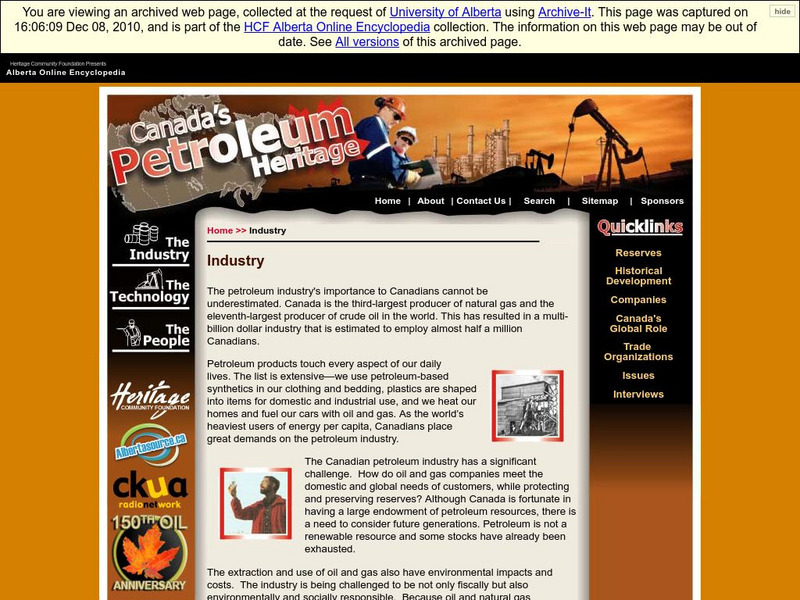Hi, what do you want to do?
Curated OER
Energy Safety Tips
Young scholars explore hazards of both electricity and natural gas when they are not properly handled. Students investigate the real-world hazards electricity and natural gas present. They participate in a simulation that illustrates the...
Curated OER
Energy Choices
Students add and multiply decimals to complete gas choice worksheets. They discover which gas supplier has the best gas prices. Students collect and interpret data about local natural gas suppliers and use this information...
Curated OER
Natural Gas Lesson-How Natural Gas Forms
Students examine background natural gas and how it is formed and what it is made of. Titles within the series include How Natural Gas Forms, What Happens to Natural Gas when it is burned, and How Natural Gas can be used. Provides very...
Encyclopedia of Earth
Encyclopedia of Earth: Physics & Chemistry: Petrochemicals
Explains what petrochemicals are, the main hydrocarbon feedstocks that form the basis of petrochemical industries, sources, uses, and products made from petrochemicals. (Published: September 25, 2011)
Encyclopedia of Earth
Encyclopedia of Earth: Natural Gas
Explains what natural gas is, how it is formed, its composition, measurement terminology, how companies locate and extract it, processing, how it is transported and stored, uses, and safety considerations. (Published: September 20, 2011)
Encyclopedia of Earth
Encyclopedia of Earth: Chemical Engineering: Natural Gas Processing
Explains the composition of natural gas and what is required to make it market-ready, types of reservoirs, and what happens in a natural gas processing plant. Includes a diagram showing the whole process. (Published: September 12, 2011)
Encyclopedia of Earth
Encyclopedia of Earth: Natural Gas: Liquefied Natural Gas
Article discussing what liquefied natural gas is, the liquefaction process, its history, how it is transported and stored, and safety considerations. (Published: September 13, 2011)
Other
Texas Comptroller of Public Accounts: The Energy Report: Natural Gas [Pdf]
Chapter 5 of a report on the energy industry in Texas. It looks at natural gas, its history, and its uses. The economic impact of the natural gas industry in Texas is described, consumption, production, distribution through pipelines,...
National Geographic
National Geographic: Extracting Gas From Shale
This lesson examines how geologists locate deposits of natural gas in deep shale formations, and the process of hydraulic fracturing that is used to extract it. Includes handouts, a vocabulary list with definitions, and an interactive on...
National Geographic
National Geographic: Evaluating Natural Gas
In this lesson, students examines the benefits and the environmental risks of extracting natural gas from shale. Includes handouts, a vocabulary list with definitions, and an interactive on how gas is extracted from shale.
National Geographic
National Geographic: Natural Gas: A Cleaner Energy Solution?
For this activity, students read informational text on natural gas and compare it to other fossil fuels for its greenhouse gas emissions and environmental impact. They then prepare a pro or con position on whether natural gas is good...
Nature Conservancy
The Nature Conservancy: Renewable Energy
In this lesson, students explore solar and wind power-two important renewable energy sources.
US Energy Information Administration
U.s. Eia Energy Kids: Nonrenewable Energy Sources
This resource provides information about nonrenewable energy sources. There is specific information about each of these energy sources, and lots of maps, charts, tables, and graphs to further the understanding.
National Geographic
National Geographic: Encyclopedic Entry: Non Renewable Energy
A good primer on non-renewable energy sources. Covers the overall advantages and disadvantages, and discusses the different types and their pros and cons. Includes a slideshow with captions.
State Energy Conservation Office-Texas
State Energy Conservation Office: Clean Energy From Texas Landfills [Pdf]
Explains what landfill gas is, some of its applications, and how Texas is harnessing it as a source of renewable energy.
Energy4Me
Energy4me: Pump It Up
Learners will learn how oil and natural gas are pumped or recovered from the earth.
Energy4Me
Energy4me: Great Energy Debate
After learning about all the energy sources, students will be able to list and identify the economic and environmental advantages and disadvantages of them.
National Academies of Sciences, Engineering, and Medicine
The National Academies: Our Energy Sources: Natural Gas
Energy production from natural gas is less destructive to the environment than energy produced from coal, but it is still produced from fossil fuels. While advances have been made in reducing its detrimental effects, our resources are...
eSchool Today
E School Today: Non Renewable Energy
Learn what non-renewable energy is and the different types.
Energy for Sustainable Development
Esd Bulgaria: Kids & Energy: Natural Gas
Learn how natural gas forms, how scientists find it beneath the Earth's surface, and how it is produced, stored, and transported.
National Academies of Sciences, Engineering, and Medicine
The National Academies: Our Energy Sources: Fossil Fuels
An overview of fossil fuels used in the United States. Coal, oil and natural gas are listed with information about each energy source.
Alberta Online Encyclopedia
Alberta Online Encyclopedia: Canada's Petroleum Heritage
Petroleum! Where does it come from? Follow its importance, technology, rank in the world, products, and more.. in this colorful, informative web site.
Polk Brothers Foundation Center for Urban Education at DePaul University
De Paul University: Center for Urban Education: Natural Gas: An Energy Resource [Pdf]
"Natural Gas: An Energy Resource" is a one page, nonfiction, reading passage about how natural gas is located, drilled for, and sent through pipelines throughout the country to people's homes. It is followed by questions which require...













![Texas Comptroller of Public Accounts: The Energy Report: Natural Gas [Pdf] eBook Texas Comptroller of Public Accounts: The Energy Report: Natural Gas [Pdf] eBook](https://static.lp.lexp.cloud/images/attachment_defaults/resource/large/FPO-knovation.png)










